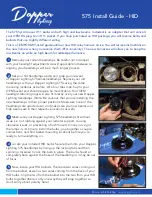
DRIVER SUPPORT
* Option/accessory, for more information, see Introduction.
266
Park Assist Pilot (PAP)
*
- limitations
The PAP sequence is stopped:
•
if the car is driven too quickly - above 7 km/h
(4 mph)
•
if the driver touches the steering wheel
•
if the ABS
33
or ESC
34
function is engaged -
e.g. if a wheel loses grip on a slippery road
surface.
A text message indicates where the PAP
sequence was stopped.
Dirt, ice and snow covering the sensors will
reduce their function and may prevent meas-
urement.
Under certain circumstances, PAP is unable
to find parking spaces - one reason for this
may be the fact that there is interference with
the sensors from external sound sources
which emit the same ultrasound frequencies
as those with which the system works.
Examples of such sources include horns, wet
tyres on asphalt, pneumatic brakes and
exhaust noises from motorcycles etc.
To bear in mind
The driver should bear in mind that the Park
Assist Pilot is an aid – not an infallible, fully-auto-
matic function. The driver must therefore be pre-
pared to intervene. There are also a few details to
bear in mind while parking, e.g.:
•
PAP starts out from the current location of
the parked vehicles - if they are inappropri-
ately parked then the car's tyres and wheel
rims may be damaged against kerbs.
•
PAP is designed for parking on straight
streets, not sharp curves or bends. For this
reason, make sure the car is parallel to the
parking space when PAP measures the
space.
•
It is not always possible to find parking
spaces on narrow streets since there is not
enough space for manoeuvring. In such park-
ing situations, it helps the system to drive as
close to the side of the road as possible
where you intend to park.
•
Bear in mind that the front of the car may
swing out towards oncoming traffic while
being parked.
•
Objects situated higher than the detection
areas of the sensors are not included when
calculations are made for the parking
manoeuvre. This may cause PAP to swing
into the parking space too early, and hence
such parking spaces should be avoided.
•
The driver is responsible for determining
whether the space selected by PAP is suita-
ble for parking.
•
Use approved tyres
35
with the correct tyre
pressure - this affects PAP's ability to park
the car.
•
Heavy rain or snow may cause the system to
measure the parking space incorrectly.
•
Do not use PAP if snow chains or a spare
wheel are fitted.
•
Do not use PAP if loaded objects are pro-
truding from the car.
33
(Anti-lock Braking System) - Anti-lock braking system.
34
(Electronic Stability Control) - Electronic stability control.
35
"Approved tyres" refers to tyres of the same type and make as those fitted new on delivery from the factory.
Summary of Contents for S 60
Page 1: ...OWNER S MANUAL ...
Page 2: ......
Page 13: ...INTRODUCTION ...
Page 28: ......
Page 29: ...SAFETY ...
Page 58: ......
Page 59: ...INSTRUMENTS AND CONTROLS ...
Page 61: ...INSTRUMENTS AND CONTROLS 59 Overview left hand drive cars ...
Page 64: ... INSTRUMENTS AND CONTROLS 62 Overview right hand drive cars ...
Page 123: ...CLIMATE CONTROL ...
Page 146: ......
Page 147: ...LOADING AND STORAGE ...
Page 156: ......
Page 157: ...LOCKS AND ALARM ...
Page 185: ...DRIVER SUPPORT ...
Page 270: ......
Page 271: ...STARTING AND DRIVING ...
Page 323: ...WHEELS AND TYRES ...
Page 345: ...WHEELS AND TYRES 343 Country Area Brazil Ukraine ...
Page 346: ... WHEELS AND TYRES 344 Country Area Israel ...
Page 356: ......
Page 357: ...MAINTENANCE AND SERVICE ...
Page 409: ...MAINTENANCE AND SERVICE 407 Related information Rustproofing p 404 ...
Page 410: ......
Page 411: ...SPECIFICATIONS ...
Page 438: ......
Page 451: ......
















































